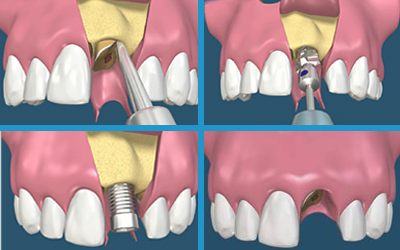
Immediate Implant
What is Immediate Implant?
The session in which the tooth is extracted means the application of the implant immediately and the tooth being built on it. In order to make an immediate implant, there should not be an active infection in the tooth and there should be enough bone in the area to be applied. Tooth extraction should be done as little traumatic as possible and if needed, bone graft (powder) should be added around the implant.
Since 1989, the implant protocol that is performed after the Lazzara tooth extraction has been defined.
In order to ensure primary stability, the length of the implant is as long as the bone allows, it is recommended to place large diameter implants for immediate implantation. Large diameter implants will fill the alveolar space better. Increase in implant diameter increases the stability of the implant.
Usage areas of the implant;
After extraction of all teeth without any source of infection
Traumatic tooth ruptures in which the bone is preserved
Endodontic (root canal treatment) complications requiring extraction
Tooth root cracks and fractures
• Permanent tooth and deciduous tooth resorption
Internal or external root resorption
Root resorption after orthodontic dental treatment
Advantages of the immediate implant;
• Very little alveolar bone resorption after tooth extraction
• The treatment time is considerably shorter
• reduction in surgical procedures
• Better physiological adaptation of the patient
Disadvantages of immediate implants;
Difficult closing of the immediate implant area by the gum
Sometimes inadequate stability of the implant
Situations where an immediate implant cannot be made;
• Severe bone loss before or after tooth extraction
• Insufficient amount of bone in the apical of the tooth to provide retention of the implant
Anatomical formation (nerve, sinus)
• Advanced infections that require tooth extraction


Leave a Comment
(0 Comments)